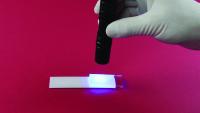
Bonding Acrylics*
Acrylic plastic has high optical clarity, low UV sensitivity and is shatter resistant. It is extremely rigid, lightweight, machinable and can be cut into almost any shape. Often used as a replacement for glass, acrylic plastic can withstand exposure to inorganic acids and alkalis. Its tensile and flexural strength are favorable.
PMMA is used in a wide range of applications for many industries. From syringes to blood filters to incubators to IV systems, acrylics can play an important role in medical device manufacturing. They are also utilized in:
- Instrument panels
- Optical appliances
- Display cases
- Paneling
- Optical fibers
- Lenses
For more information on bonding plastic substrates take a look at our surface preparation guide.
Considerations for Bonding Acrylic
Outstanding products for bonding acrylics include EP21LV, EP30-2, MasterSil 151 and UV15-7. Low viscosity epoxy system EP21LV cures at room temperature and is easy to apply. Rigidity and flexibility can be adjusted by altering the mix ratio. Optically clear EP30-2 meets NASA low outgassing requirements. This rigid formulation has superior dimensional stability and electrical insulation properties. Highly flexible, thermally stable MasterSil 151 displays superb light transmission characteristics. Its elongation is 120-150%. UV15-7 features superior physical strength properties, low shrinkage upon curing and good non-yellowing stability.
*Manufacturers and trade names for acrylic include: CYRO Industries (Acrylic®), Atofina (Plexiglass®), Lucite International (Lucite®) and Arkema Group (Oroglass®).
Master Bond Popular Products
 |
UV10-FD One component, UV curable adhesive contains a flourescent dye for identification. High strength bonds and superior chemical resistance properties. Low viscosity. Excellent dimensional stability. Fast curing. Serviceable from -60°F to +300°F. |
